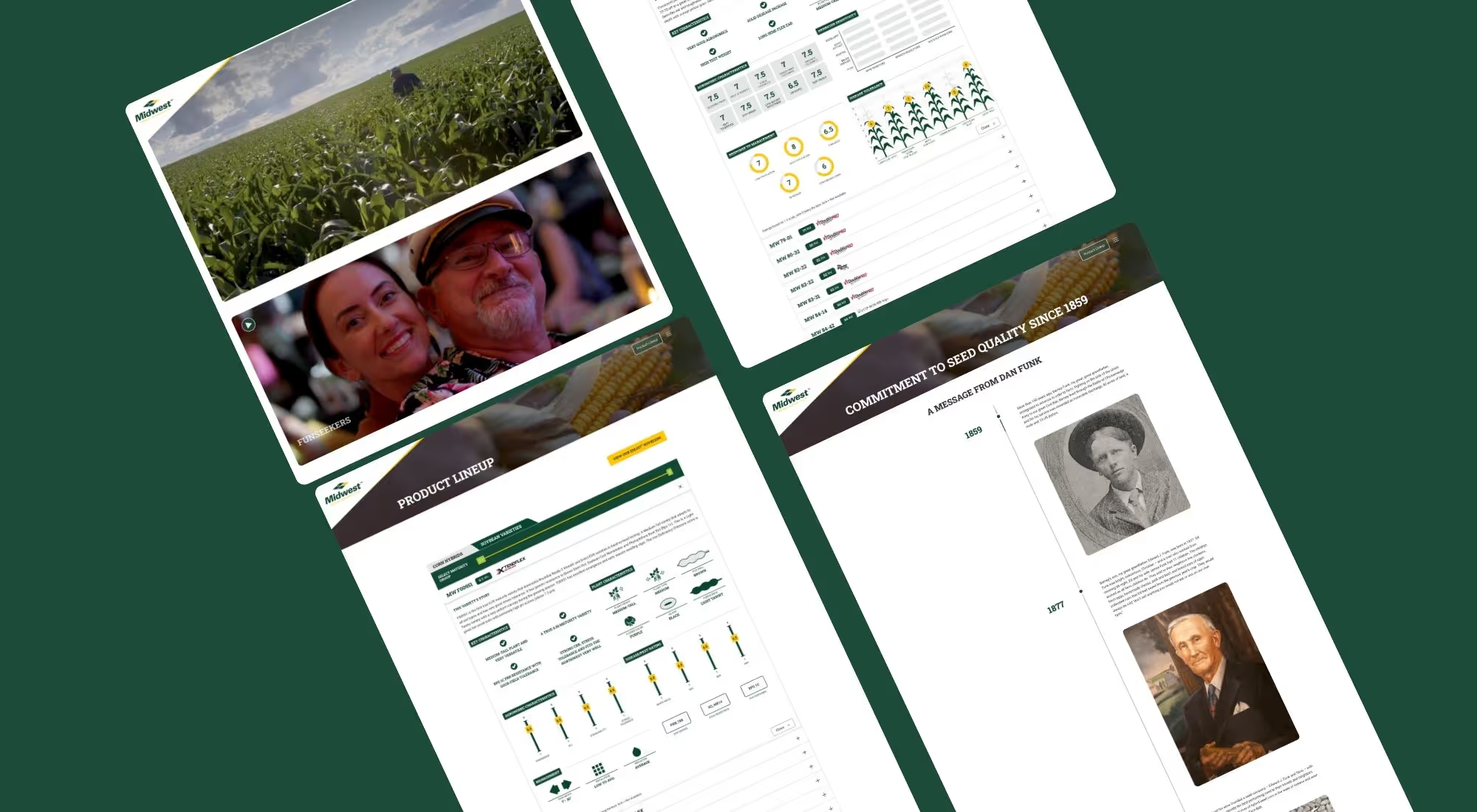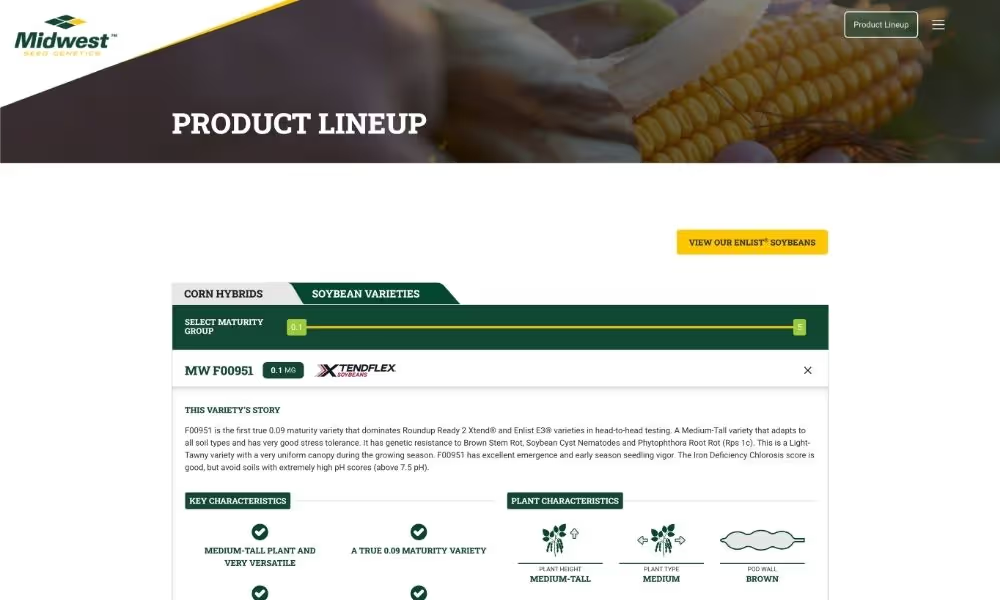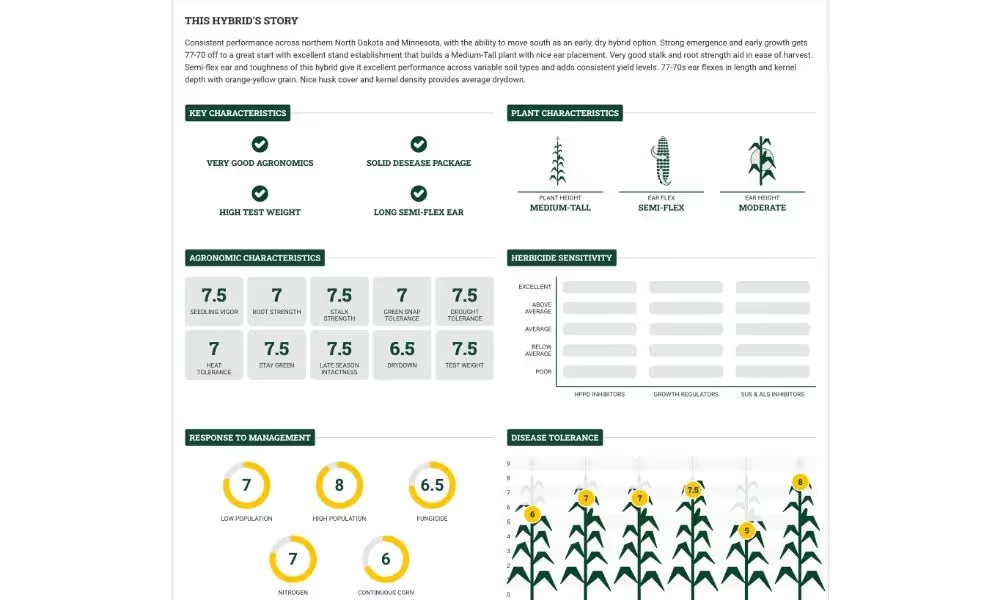
Midwest Seed
Streamlining Agricultural Data Management with Webflow and Airtable Integration
The Midwest Seed website represents a sophisticated solution to a complex content management challenge in the agricultural sector. As a national seed company with an extensive product catalog that needs to be distributed across five distinct brand websites, Midwest Seed required a system that could maintain data consistency while allowing for brand-specific presentations and filtering capabilities.
Technical Architecture and Integration
At the core of the Midwest Seed website is a powerful integration between Webflow's front-end capabilities and Airtable's robust database functionality. This integration is facilitated through DataFetcher, creating a seamless data pipeline that transforms how agricultural product information is managed and presented to customers.
The technical architecture employs a centralized data management approach where all product information—including seed varieties, maturity ratings, performance metrics, and regional adaptation data—is maintained in a structured Airtable database. This single source of truth ensures consistency across all brand presentations while dramatically reducing the maintenance burden that would typically come with managing multiple separate websites.
DataFetcher serves as the crucial middleware that pulls information from Airtable and injects it into the Webflow CMS, allowing for dynamic content presentation without sacrificing the design quality and user experience that Webflow excels at providing. This integration enables real-time updates across all five brand sites whenever product information is modified in the central database.
User-Centric Filtering and Search Capabilities
One of the most valuable features of the Midwest Seed website is its sophisticated filtering system that allows farmers and agricultural professionals to quickly find the exact seed varieties that match their specific growing conditions and requirements. The filterable seed search functionality includes:
Maturity-Based Filtering: Users can filter seed varieties based on maturity ratings, a critical factor in crop planning that determines growing season length requirements.
Regional Adaptation Filters: The system allows filtering based on geographic suitability, helping farmers identify varieties specifically bred or tested for their local conditions.
This filtering system is built with agricultural decision-making processes in mind, recognizing that seed selection is a complex decision with significant financial implications for farmers. The intuitive interface makes sophisticated data filtering accessible even to users with limited technical expertise.

Data Visualization and Animated Graphics
Beyond basic product information, the Midwest Seed website elevates data presentation through animated and interactive data graphics that help visualize complex agricultural performance metrics. These visualizations include:
These animated data graphics transform complex agricultural data into intuitive visual formats that help farmers make more informed decisions. The animations engage users while communicating technical information in an accessible way, bridging the gap between scientific data and practical application.
Content Management Efficiency
From an administrative perspective, the integration of Airtable and DataFetcher with Webflow creates remarkable efficiency gains. The content management workflow allows:
Centralized Updates: Product information can be updated once in Airtable and automatically reflected across all five brand websites.
Consistent Branding with Variation: Each brand site maintains its unique identity while drawing from the same underlying product data.
Streamlined Seasonal Updates: The agricultural industry's seasonal nature requires regular updates to product recommendations and availability, which can now be managed through a single interface.
Results and Impact
The implementation of this integrated website system has delivered significant benefits for both Midwest Seed and its customers:
Increased User Engagement: Session duration increased as users engage more deeply with the interactive filtering and visualization tools.
Operational Efficiency: The marketing team now manages five brand websites with the same effort previously required for a single site.
Data Consistency: Product information remains consistent across all brand presentations, eliminating previous issues with contradictory information.
Faster Market Response: New products or updated information can be deployed across all platforms within minutes rather than days.

Technical Implementation Details
The technical implementation leverages several advanced features of both Webflow and Airtable:
Custom API Integration: DataFetcher connects to Airtable's API to pull structured data into Webflow's CMS collections.
Conditional Visibility: Different elements display based on selected filters, creating a dynamic user experience without page reloads.
Custom Animation Framework: The animated data graphics utilize a combination of CSS animations and JavaScript to create smooth, informative visualizations.
Conclusion
The Midwest Seed website demonstrates how thoughtful integration between Webflow's design capabilities, Airtable's database functionality, and DataFetcher's connection tools can solve complex content management challenges while delivering an enhanced user experience. By focusing on the specific needs of agricultural professionals—from data-driven decision making to field usability—the website serves as both a marketing platform and a valuable decision support tool for customers.
This case study illustrates the power of modern web technologies to transform industry-specific challenges into opportunities for improved customer experience and operational efficiency. The architecture provides a scalable foundation that can grow with the company's product line while maintaining the streamlined management approach that makes it so efficient.

